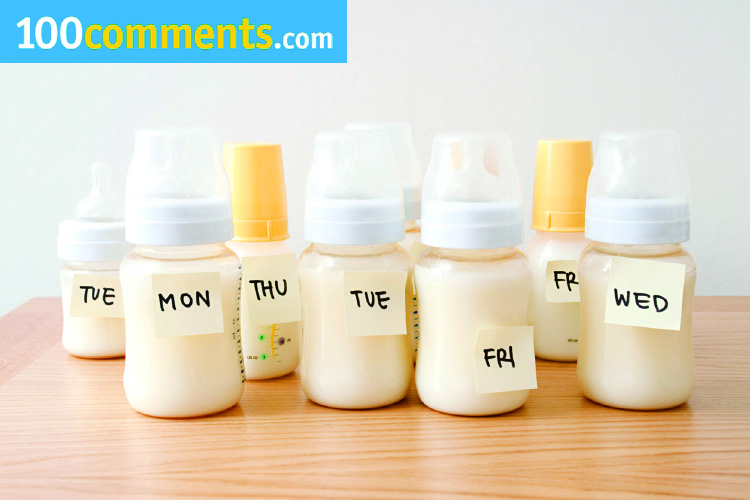Most nursing mums can’t help but wonder if their precious little bundle is getting enough milk. While babies and crying are synonymous, the last thing any mum would want is to suspect that their baby’s cries is because of unfulfilled hunger, for after all, it’s not like one can see how much milk a baby is drinking while he or she is being breastfed! Still, there are signs you could look out for to put your mind at ease.
Most nursing mothers are able to provide all the milk needed for their little one’s nourishment. Still, there may be incidents when a baby doesn’t get enough. When this situation isn’t addressed, a baby can suffer from dehydration and failure to thrive. While these conditions are uncommon, they are, nevertheless, serious.
Table of Contents
For most mums, the following will be observed to signify that their breastfeeding baby is getting enough nourishment:
- The breasts feel softer after nursing, because her baby has emptied some of the milk that was making them firm.
- After a feeding, the baby seems relaxed and satisfied.
- During the first few days, when a nursing baby is feeding on colostrum, he or she might go through only one or two wet diapers a day. As soon as a mum’s milk come in, the baby will begin to wet six to eight cloth diapers a day, or five or six disposables.
- Most babies lose between 5 and 9 percent of their birth weight and then regain it by the time they’re about 2 weeks old. Following that, the baby should continue to gain weight. As a rough guideline, for the first month, a baby should gain 5 to 10 ounces a week; in months 2 and 3, the weight gain should be about 5 to 8 ounces a week; in months 3 to 6 it should be between 2.5 and 4.5 ounces a week; and from 6 to 12 months, the baby should be putting on 1 to 3 ounces a week.
- During the first month of a baby’s life, he or she will pass motion at least three times a day. The stools will lighten to a yellowy mustard color by the fifth day after birth. The baby may have less frequent bowel movements once he or she is a month old. In fact, it’s not uncommon for breastfed babies to skip a day of bowel movements now and then. When a baby begins to eat solid foods, motion passing will become quite regular and babies usually will have at least one bowel movement a day.
How much pumped breast milk is enough?
If you feed your baby pumped breast milk, you can follow these guidelines to know how much your baby will need:
Up until a month old, most babies will take 2.5 to 3 ounces of breast milk in a bottle, feeding about eight times a day, for a total of 20 to 24 ounces in 24 hours. After that, the average amount of breast milk until 6 months of age is around 26 to 28 ounces per day, divided into six to eight feedings.
If solids are started earlier than 6 months, the amount of breast milk a baby takes will decrease.
Note: As these are just rough guidelines, please do not attempt to force feed your little one the total accumulated amount each day as a rule. An exclusively breastfed baby should be taking in at least 25 ounces a day, though.
Play by ear
- Don’t hold back if your baby still seems hungry, and nurse as often as baby ‘asks’.
- In the meantime, don’t try to stuff your baby because you think there’s a certain amount the little one should be getting.
Overfeeding a bottle-fed baby
If a baby is bottle-fed, either breast milk or formula, it is all too easy to overfeed the little one. While a breastfed baby can comfort at the breast while getting just a minimal amount of milk, or drink just enough to quench a thirst even, it’s a bit tricky for a bottle fed baby! If your bottle-fed baby wants just a little milk, he or she usually winds up getting much more then needed because of how fast the bottle flows and the fact that it’s not easy for a baby to control the flow of milk from a bottle’s nipple.
Helping baby along
There are some things you can do to ensure your baby gets just the right amount of milk and also, prevent overfeeding. Firstly, feed baby slowly and take little breaks to give the little one a chance to let you know when he or she has had enough. Tip: If your baby seems to be gulping the breast milk quickly, help him or her to catch their breath by taking a break every ten sucks or so. This is especially important during the first couple of months, until babies learn to pace themselves.
Babies who are between 7- to 11-month-old will need a variety of solid food daily along with some snacks and four to five servings of breast or formula milk to thrive. It’s common for babies to decrease the amount of milk they take in as they increase their solid food intake.
When a baby is a year old, you may transition to whole cow’s milk using a bottle or sippy cup. Keep in mind that it’s easy to overdo it with cow’s milk too. Growing-up milk powders, for instance, have very palatable tastes and flavours and some children take to them a little too well for their own good. Once soild food is in the scene, the inclusion of milk in a child’s diet is to help close nutritional gaps such as calcium and protein needs.
Too much cow’s milk may reduce a child’s appetite for other healthy foods. In fact, too much cow’s milk may also lead to iron-deficiency anema. Stick to sixteen to 24 ounces a day to be safe.
Nursing as long as possible
A mother’s milk will always be the best form of milk for a child, be it a newborn or a toddler. You can continue to nurse your child past the first year if you and your child want to. Even though your toddler will get most of the required nutrition from solid food, your breast milk can still provide calories, valuable immunities, vitamins and enzymes the little one needs to stay in the best of health.
















